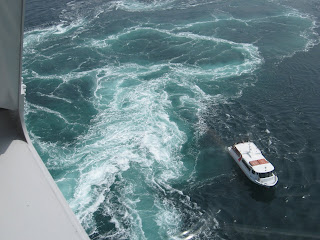Shikoku has many tourist attractions, like the Naruto whirlpools which were my first destination. The whirlpools are caused by the changing tides rushing through a narrow strait. There is a science museum at the site of the whirlpools to educate people (well, those people who can read Japanese) both on whirlpools and bridges.
At the entrance to the museum, everyone spun a bingo ball kind of thing, and the color of the ball that rolled out determined which prize you won. I was the lucky winner and was presented with a large and heavy bag of Japanese food which I then had to drag around all day, trying not to be ungrateful. Since I don’t like Japanese food, I tried to distract myself by thinking of who I should give this food to. I decided a couple of teachers at school could be the lucky recipients, including one English teacher who always eats cup of noodle for lunch (yes, it’s very popular here, but they call it “Cup Noodle”, dropping the “of”.)

After the museum, it was low tide, one of the ideal times to see the whirlpools, so I followed the crowd walking under the suspension bridge (this bridge was not the longest one in the world). The walking platform had glass windows in the floor so you could see the churning water 45 meters below you. It was cool, but the girders of the bridge really obstructed the view. I was a bit envious of those people below in the sightseeing boats.





After low tide, I moved on to my next site, a couple of the temples of the Shikoku pilgrimage. This pilgrimage is famous throughout Japan. People walk (or take a tour bus) around a circuit of 88 temples on the island. It’s about 1,400 km long and can take a couple of months to finish! The pilgrimage follows in the footsteps of a famous Buddhist priest from the 9th century.

The temple seal book I bought in Kyoto was getting full, so I decided to buy a second book and collect as many of the 88 temples’ seals as I can (but over a series of day trips with just a bit of walking). At the temple shop where I bought my new book, the Buddhist monk also gave me the white vest that pilgrims wear and insisted that I put it on. So you can imagine me, trudging along in my white vest and carrying the heavy bag of Japanese foods I really didn’t want. My serenity was severely compromised! Later I read in the brochure that the white vest used to symbolize a death shroud, showing that the pilgrim was prepared to die at any time. Luckily they didn’t give me the traditional walking staff which was formerly used as a grave marker for a pilgrim who passed away along the journey!


Surprisingly I was able to find the first three temples without too much trouble (I can just make out the basic kanji for numbers and for temple.) This coming weekend I’m going back to Shikoku and will visit a few more of the 88 temples. Maybe I’ll get a photo of myself in the white pilgrim vest then…


1 comment:
You might enjoy this:
http://www.keepingpaceinjapan.com/2007/05/ikkoku-mairi-temples-1-6.html
Post a Comment